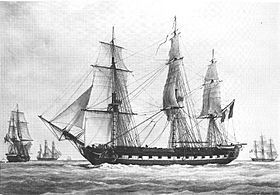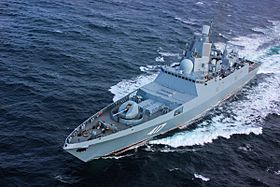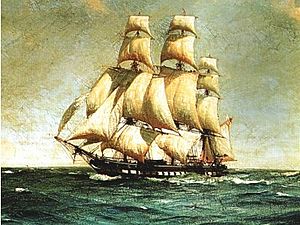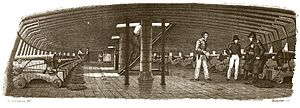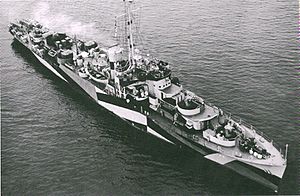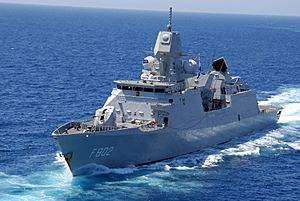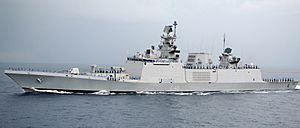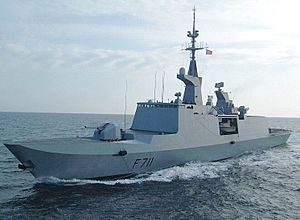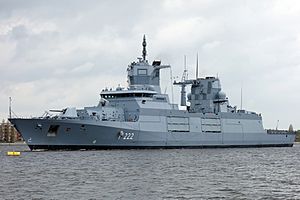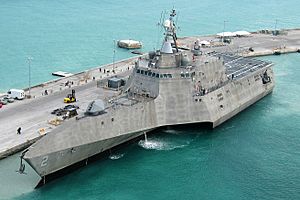Frigate facts for kids
A frigate is a type of warship, which is a ship built for fighting. Over many years, what a frigate looked like and what it could do has changed a lot.
In the 1600s and early 1700s, a frigate was any fast, easy-to-steer ship with square sails. These ships were used for scouting, protecting other ships, and patrolling. The word "frigate" was used for many different ship designs back then. Later, in the mid-1700s, France developed the "true frigate." This new type of ship had only one deck with guns. The deck below it was used for the crew to live, and it had no weapons.
By the late 1800s, powerful ironclad warships were developed. These ships had heavy armor. They were called "armored frigates" because they still had only one main deck for guns. But as ships kept changing, the term "frigate" wasn't used for these big armored ships anymore.
During World War II, the name "frigate" came back. It was used for escort ships that were bigger than corvettes but smaller than destroyers. These ships helped protect convoys from submarines. After World War II, many different ships were called frigates. Sometimes, the term was used for ships that looked more like corvettes, destroyers, or even large cruisers. Some navies in Europe even call their destroyers "frigates." The naval rank "frigate captain" comes from this type of ship.
Contents
Sailing Frigates
Early History
The word "frigate" (fregata in Italian) first appeared in the Mediterranean Sea in the late 1400s. It described a lighter type of galley warship. These early frigates used both oars and sails. They had light weapons and were built for speed and quick movements.
The word's origin is a bit unclear. It might come from a Latin word, aphractus, meaning an open boat without a lower deck. In 1583, during a war, privateers (like legal pirates) from Dunkirk developed small, fast sailing ships. They used these "Dunkirker" frigates to attack Dutch ships. Other navies saw how successful these ships were and started building similar ones. Soon, "frigate" meant any fast and elegant warship that used only sails.
The navy of the Dutch Republic was the first to build larger frigates that could sail on the open ocean. The Dutch needed ships that were fast and could sail in shallow waters. They also needed ships strong enough to fight the Spanish fleet. Around 1600, the first large battle-ready frigates were built in Holland. By the end of the Eighty Years' War, the Dutch only used lighter frigates. These ships carried about 40 guns and weighed around 300 tons.
The Dutch frigates proved how good they were in the Battle of the Downs in 1639. This encouraged other navies, especially the English, to build similar ships. In the 1650s, England built many ships called "frigates." The biggest ones were "great frigates" with two decks and 60 guns. Most other frigates were used as "cruisers," meaning they were fast ships that could operate on their own. The term "frigate" meant a long hull design, which made the ships faster. This also helped develop the "broadside" tactic, where all guns on one side fired at once.
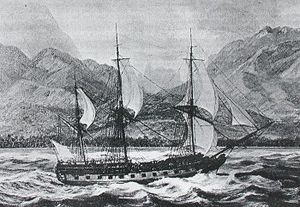
Later, some frigates even brought back oars. For example, HMS Charles Galley from 1676 had 40 oars below its upper deck. This allowed the ship to move even without wind.
Classic Design
The classic sailing frigate, famous from the Napoleonic Wars, came from French designs in the mid-1700s. The French ship Médée from 1740 is often seen as the first of this type. These ships had square sails and carried all their main guns on one continuous upper deck. The lower deck, called the "gun deck" before, now had no weapons. It became the "berth deck" where the crew lived. This deck was actually below the waterline.
Taking the guns off the lower deck allowed the ship's upper part to be lower. This made the "true frigate" much better at sailing. Also, because the guns were higher up, frigates could still fire all their weapons in rough seas. Two-deckers often couldn't open their lower deck gunports in bad weather.
The Royal Navy (British Navy) captured some of these new French frigates, including Médée, during the War of the Austrian Succession (1740–1748). They were very impressed, especially with how well these ships handled near the coast. The British quickly copied the design and made their own versions. The first British frigates had 28 guns, including twenty-four 9-pounder guns on the upper deck. Soon, they developed into larger ships with 32 or 36 guns, including twenty-six 12-pounder guns on the upper deck.
Between 1777 and 1790, France built 59 sailing frigates. They were typically about 135 feet long and could sail up to 14 knots. This was much faster than older ships.
Heavy Frigates
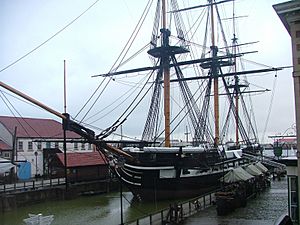
In 1778, the British Navy introduced a larger "heavy" frigate. These ships had a main battery of twenty-six or twenty-eight 18-pounder guns. France started building its own 18-pounder frigates in 1781. The 18-pounder frigate became the standard frigate during the French Revolutionary and Napoleonic Wars. The British built even larger 38-gun versions and slightly smaller 36-gun versions. They also made a 32-gun design, which was a cheaper version.
Frigates could also carry smaller guns on their quarterdecks and forecastles (the raised parts at the back and front of the upper deck). In 1778, a Scottish company created the carronade. This was a large, short-barreled naval cannon. It was light, quick to reload, and needed fewer crew members. Because it was light, it could be placed on the forecastle and quarterdeck of frigates. This greatly increased the ship's firepower. However, carronades had a much shorter range and were less accurate than regular long guns. Both the British and US Navies quickly adopted this new weapon. A typical heavy frigate had 18-pounder long guns as its main weapons, plus 32-pounder carronades on its upper decks.
Super-Heavy Frigates
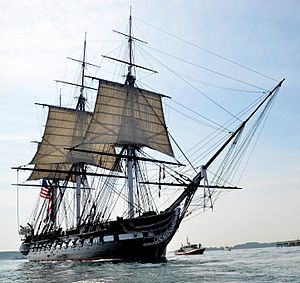
The first "super-heavy frigates" with 24-pounder long guns were built for the Swedish navy in 1782. These ships were designed to be strong enough to join the main battle line if needed. In the 1790s, France built a few large 24-pounder frigates. They also cut down older ships-of-the-line (large battleships) to make super-heavy frigates. These were called rasées.
In 1797, three of the United States Navy's first major ships were 44-gun frigates. These ships actually carried 56 to 60 24-pounder long guns and 32-pounder or 42-pounder carronades on two decks. They were incredibly powerful. These ships were so big (around 1,500 tons) and well-armed that they were often seen as equal to ships-of-the-line. After losing some battles at the start of the War of 1812, the British Royal Navy ordered its frigates (which usually had 38 guns or less) to never fight these large American frigates unless they had at least a 2-to-1 advantage.
USS Constitution, which is still preserved today, is the oldest commissioned warship still afloat. It is a great example of a frigate from the Age of Sail. Constitution and its sister ships, President and United States, were built to fight pirates and as part of the Naval Act of 1794.
The British responded to the success of the American 44-gun frigates in a few ways. They built their own 40-gun, 24-pounder frigates. They also cut down three old 74-gun ships-of-the-line into rasées. These ships had 32-pounder main guns and 42-pounder carronades, making them even more powerful than the American ships. Finally, they built Leander and Newcastle. These were 1,500-ton frigates that were almost an exact match in size and firepower to the American 44-gun frigates.
Role of Sailing Frigates
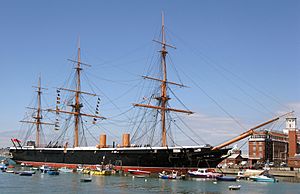
Frigates were probably the busiest warships during the Age of Sail. They were smaller than a ship-of-the-line (the biggest warships), but they were very strong against smaller ships like sloops, gunboats, and privateers. Frigates could carry enough supplies for six months, so they had a very long range. Larger ships were considered too valuable to send out alone.
Frigates would scout for the main fleet, go on missions to attack enemy trade ships, patrol, and carry messages or important people. Usually, frigates fought in small groups or alone against other frigates. They tried to avoid fighting ships-of-the-line. Even in a big fleet battle, it was considered bad manners for a ship-of-the-line to fire at an enemy frigate unless the frigate fired first.
Frigates were also important in fleet battles as "repeating frigates." In the smoke and confusion of battle, the fleet commander's signals might be missed by other ships. Frigates were placed away from the main battle line, where they could clearly see the commander's flagship. They would then repeat the signals so all ships in the fleet could see them. If the flagship was damaged and couldn't make clear signals, the repeating frigates would understand them and send them correctly.
For officers in the Royal Navy, serving on a frigate was a good thing. Frigates often saw action, which meant a better chance for glory, promotion, and prize money (money from captured enemy ships).
Unlike larger ships that were stored away in peacetime, frigates were kept in service. This saved money and gave captains and officers valuable experience for wartime. Frigates could also carry marines for boarding enemy ships or for operations on land. For example, in 1832, the frigate USS Potomac landed 282 sailors and Marines ashore in a US Navy mission.
Frigates were a key part of navies until the mid-1800s. The first ironclad warships were called "frigates" because of how many guns they carried. But as iron and steam became common, the role of the frigate was taken over by other types of ships.
Steam Frigates

Ships called frigates continued to be important when steam power was adopted in the 1800s. In the 1830s, navies tried out large paddle steamers with big guns on one deck. These were called "paddle frigates."
From the mid-1840s, frigates that looked more like the old sailing frigates were built with steam engines and propellers. These "screw frigates" were first made of wood, then later of iron. They continued to do the traditional frigate jobs until the late 1800s.
Armored Frigates
Starting in 1859, armor was added to ships based on existing frigate designs. The extra weight of the armor meant these first ironclad warships could only have one gun deck. So, they were technically frigates, even though they were much more powerful than older ships-of-the-line. The term "armored frigate" was used for a while to describe these sail-equipped, broadside-firing ironclad ships.
By the 1880s, warship design changed from iron to steel. Cruising warships without sails started to appear. The term "frigate" then fell out of use. Ships with armored sides were called "battleships" or "armored cruisers." Ships with only an armored deck were "protected cruisers." Unarmored ships, including frigates and sloops, were called "unprotected cruisers."
Modern Frigates
World War II Frigates
Modern frigates are related to older frigates only by name. The British Royal Navy brought back the term "frigate" during World War II. They used it for anti-submarine escort ships. These were larger than corvettes but smaller than destroyers. They were similar in size and ability to the American destroyer escorts. Frigates were usually cheaper to build and maintain.
The frigate was created to fix problems with the older corvette design. Corvettes had limited weapons, weren't good in open oceans, and had only one propeller, which limited their speed. Frigates were designed to be simple, strong ships for all weather. They could be built quickly in many shipyards. The first frigates, like the River class (1941), were basically two corvette engines in a larger hull. They were armed with the new Hedgehog anti-submarine weapon.
Frigates had less firepower and speed than destroyers. But these qualities weren't needed for fighting submarines. Submarines were slow underwater, and ASDIC (sonar) didn't work well at speeds over 20 knots. Instead, frigates were built for mass production and had the latest anti-submarine technology. Since frigates were only meant for convoy duties, they didn't need a huge range or speed.
The British Bay class of 1944 was the first British design called a "frigate" that was made for fleet use. These anti-aircraft frigates were built on unfinished Loch-class hulls. They were similar to the United States Navy's destroyer escorts (DEs). The American DEs were faster and had more weapons, making them better for fleet operations. The US Navy's "patrol frigates" (PFs), like the Tacoma class, were also similar.
Modern Frigates Today
Guided-Missile Role
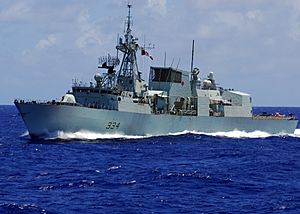
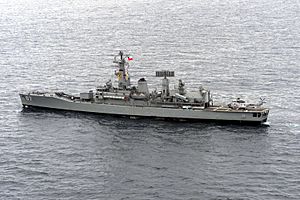
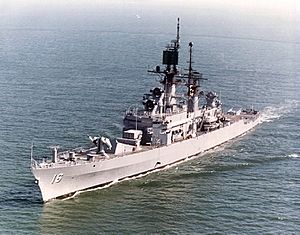
After World War II, surface-to-air missiles were invented. These missiles made even small ships good at anti-aircraft warfare. These ships were called "guided-missile frigates." In the US Navy, they were first called "ocean escorts." The Royal Canadian Navy and British Royal Navy kept using the term "frigate."
From the 1950s to the 1970s, the US Navy had ships called guided-missile frigates (DLG or DLGN). These were actually anti-aircraft cruisers built on destroyer-style hulls. They had launchers for missiles like the RIM-2 Terrier. These ships were mainly meant to protect aircraft carriers from anti-ship cruise missiles. They also had anti-submarine abilities. Some of these ships were nuclear-powered. These "frigates" were about halfway in size between cruisers and destroyers. This was different from other navies, which saw frigates as smaller than destroyers.
In 1975, the US Navy changed its ship classifications. The large American frigates were renamed guided-missile cruisers or destroyers. Smaller "ocean escorts" were reclassified as frigates (FF/FFG). In the late 1970s, the US Navy introduced the Oliver Hazard Perry guided-missile frigates (FFG). The last of these was taken out of service in 2015 in the US, but some still serve in other navies.
One very successful design after 1945 was the British Leander class. Many navies used them. These ships were built starting in 1959. They were designed for both anti-submarine and anti-aircraft use.
Almost all modern frigates have missiles for attacking or defending. Because of this, they are called guided-missile frigates (FFG). Modern surface-to-air missiles allow these frigates to be the main defense ships for many navies. They can protect a whole fleet without needing special anti-air frigates.
Modern destroyers and frigates can travel long distances in open water. So, they are considered "blue water" vessels. Smaller corvettes are usually used closer to the coast. Experts say that destroyers are bigger and can carry more powerful radars and more missile launchers. They can protect large groups of ships, like aircraft carrier groups. Frigates are usually used as escort ships to protect trade routes or as a smaller part of a strike group. The largest destroyers are sometimes called cruisers because they have extra weapons and can serve as flagships for a fleet.
Anti-Submarine Role
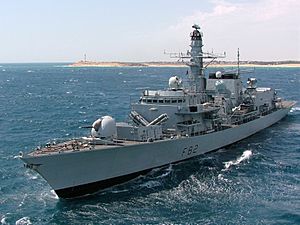
Some frigates are specially designed for anti-submarine warfare. As submarines became faster after World War II, frigates also needed to be faster. Post-war frigates, like the Whitby class, were built for speed.
These ships have better sonar equipment, like towed arrays, which are long cables with sensors dragged behind the ship. They also have special weapons like torpedoes and missile-carried anti-submarine torpedoes. The Royal Navy's original Type 22 frigate is an example of a specialized anti-submarine frigate. It also had Sea Wolf missiles for defense and Exocet missiles for attacking other ships.
Most modern frigates have a landing deck and hangar at the back for helicopters. This means the frigate doesn't have to get close to unknown submarines. Fast helicopters can attack nuclear submarines, which might be faster than surface ships. For this job, helicopters have sensors like sonobuoys (floating sonar devices) and magnetic anomaly detectors to find threats. They also carry torpedoes or depth-charges to attack them.
Helicopters with radar can also scout for targets far away. If they have anti-ship missiles, they can attack targets too. Helicopters are also very useful for search and rescue missions. They have largely replaced small boats for moving people, mail, and cargo between ships or to shore. Helicopters do these jobs faster and more safely, without the frigate needing to slow down.
Air Defense Role
Frigates designed in the 1960s and 1970s, like the US Navy's Knox class, had a few short-range surface-to-air missiles for self-defense.
Newer frigates, starting with the Oliver Hazard Perry class, are designed for "zone-defense" anti-aircraft warfare. This is because fighter jets and ballistic missiles have become much more advanced. Recent examples include the De Zeven Provinciën air defense frigate of the Royal Netherlands Navy. These ships have advanced missiles and radar systems for air defense. Another example is the Iver Huitfeldt class of the Royal Danish Navy.
New Developments
Stealth technology has been added to modern frigate designs. The French La Fayette design was one of the first. Frigates are now shaped to have a very small radar cross section, meaning they are hard for radar to detect. This also helps them move quickly through the air. These frigates are so easy to maneuver that they have been compared to old sailing ships. Examples include the Italian and French Horizon frigates with anti-missile capabilities, and the German Sachsen class.
The modern French Navy uses the terms "first-class frigate" and "second-class frigate" for both destroyers and frigates. This can be confusing because some French ships are called frigates, while similar ships in other navies are called destroyers. This means some recent French ships, like the Horizon class, are among the largest ships in the world to be called frigates.
The Frégates de Taille Intermédiaire (FTI), meaning "frigates of intermediate size," is a French program to design new frigates. Five of these ships are planned, with the first expected to be ready around 2023.
In the German Navy, frigates have replaced older destroyers. However, the new German frigates are larger and do more jobs than the old destroyers. The future German F125 frigates are the largest class of frigates in the world, weighing over 7,200 tons. The Spanish Navy also uses the Aegis frigates, like the Álvaro de Bazán class.
The Myanmar Navy is building modern frigates with reduced radar cross section, like the Kyan Sittha class. Even though the Myanmar Navy is small, it is building modern guided-missile frigates with help from other countries.
Littoral Combat Ship (LCS)
Some new types of ships, similar to corvettes, are designed for fast deployment and fighting small boats. An example is the U.S. littoral combat ship (LCS). By 2015, all Oliver Hazard Perry frigates in the US Navy were taken out of service. Their role is partly being taken over by the new LCS ships. While LCS ships are smaller than the frigates they replace, they have similar weapons but need less than half the crew. They can also go over 40 knots. A big advantage of LCS ships is that they are designed with special "mission modules." These modules allow them to do many different jobs. The modular system also means most upgrades can be done on land and then installed on the ship later. This keeps the ships available for duty for longer periods.
The US Navy's plans mean that for the first time since 1943, the US Navy has not had a frigate class of ships. (Technically, USS Constitution is still a commissioned frigate, but it's a museum ship and doesn't count towards active Navy numbers).
The US Navy plans to get 20 more LCSs from 2019 onwards. These enhanced ships will be called frigates. Existing LCS ships might also be reclassified as frigates if they get modifications.
Frigates in Preservation
A few frigates have been saved and are now museum ships:
Original Sailing Frigates
- USS Constitution in Boston, United States. This is the second oldest commissioned warship in the world and the oldest commissioned warship still afloat. It is still active as the flagship of the United States Navy.
- NRP Dom Fernando II e Glória in Almada, Portugal.
- HMS Trincomalee in Hartlepool, England.
- HMS Unicorn in Dundee, Scotland.
Replica Sailing Frigates
- Hermione, a sailing replica of the 1779 Hermione. This ship carried Lafayette to the United States.
- Étoile du Roy, originally named Grand Turk. It was built for the TV series Hornblower in 1997. It was sold to France in 2010 and renamed Étoile du Roy.
- Russian frigate Shtandart, a sailing replica of Russia's first warship, located in Saint Petersburg, Russia.
- HMS Surprise in San Diego, United States. This is a replica of HMS Rose, used in the film Master and Commander: The Far Side of the World.
Steam Frigates
- HNLMS Bonaire in Den Helder, Netherlands.
- Danish frigate Jylland in Ebeltoft, Denmark.
- Japanese frigate Kaiyō Maru, a replica in Esashi, Japan.
- HMS Warrior in Portsmouth, England.
- ARA Presidente Sarmiento in Buenos Aires, Argentina.
Modern Era Frigates
- HDMS Peder Skram in Copenhagen, Denmark.
- HMAS Diamantina in Brisbane, Australia.
- TCG Ege (F256), formerly USS Ainsworth in Izmit, Turkey.
- ROKS Taedong (PF-63), formerly USS Tacoma in South Korea.
- ROKS Ulsan (FF-951), in Ulsan, South Korea.
- ROKS Seoul (FF-952), in Seoul, South Korea.
- HTMS Tachin (PF-1), formerly USS Glendale in Nakhon Nayok, Thailand.
- HTMS Prasase (PF-2), formerly USS Gallup in Rayong Province, Thailand.
- HTMS Phutthaloetla Naphalai in Sattahip, Thailand.
- HTMS Phutthayotfa Chulalok in Sattahip, Thailand.
- CNS Yintang (FFG-531) in Qingdao, China.
- CNS Xiamen (FFG-515) in Taizhou, China.
- CNS Ji'an (FFG-518) in Wuxue, China.
- CNS Siping (FFG-544) in Xingguo County, China
- CNS Jinhua (FFG-534) in Hengdian, China
- CNS Dangdong (FFG-543) in Dangdong, China
- HMS President in London, England.
- HMS Wellington in London, England.
- HMS Ambuscade in Glasgow, Scotland (planned)
- HNoMS Narvik in Horten, Norway.
- KD Hang Tuah in Lumut, Malaysia.
- UBS Mayu in Yangon, Myanmar
Images for kids
See also
 In Spanish: Fragata para niños
In Spanish: Fragata para niños



